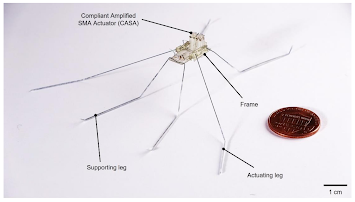Introduction: The Rise of Smart Metal
Imagine a metal that can remember its shape, even after bending and twisting and can snap back into place. Sounds like something out of Terminator 2: Judgment Day, doesn’t it? Or perhaps a futuristic Cyberpunk 2077 cybernetic limb?
Those metals, also known as Shape Memory Alloys (SMAs), are no longer just science fiction. These materials are revolutionizing robotics, aerospace, and medical technology, bringing us closer to the future envisioned in our favorite movies and video games.
The Sci-Fi Magic of Shape Memory Alloys
While Nickel-Titanium (NiTi), or Nitinol, is the most well-known SMA, researchers have developed other types to suit different applications:
-
Nickel-Titanium (NiTi) – The most commonly used SMA, found in robotics and medical implants. Think of the exosuits in Edge of Tomorrow, where soldiers wear adaptive armor that enhances movement.
-
Copper-Based Alloys (Cu-Al-Ni, Cu-Zn-Al) – Lighter and cheaper, used in aerospace applications. Similar to Titanfall's mech technology, which optimizes movement while reducing weight.
-
Iron-Based Alloys (Fe-Mn-Si) – Highly durable and corrosion-resistant, being researched for self-healing materials. Imagine Adamantium-like properties in Wolverine’s skeleton!
SMA in Robotics: Sci-Fi and Gaming Becoming Reality
1. Humanoid Robot Actuators – Westworld Meets Detroit: Become Human
SMAs offer compact, silent movement, making robotic limbs eerily lifelike. Scientists are developing SMA-powered hands that mimic human tendons, much like the realistic androids in Westworld or the cybernetic enhancements in Detroit: Become Human.
  |
2. Miniature Robots – The Black Mirror Swarm Meets Horizon Zero Dawn
SMAs enable micro-robots that navigate tight spaces, useful for medical and surveillance applications. Black Mirror’s robotic bee swarm and Horizon Zero Dawn’s AI-controlled Corruptors aren’t just fiction—SMA-driven micro-drones could revolutionize search-and-rescue missions. Figure 2 shows a working water-walking microrobot, which is a step closer to the robotic bee swarm mentioned earlier.
Beyond Robotics: SMAs in Other Fascinating Arenas
Medical Technology – Cyberpunk 2077’s Cybernetic Limbs and Star Trek’s Regeneration Tools
From self-expanding stents to shape-adaptive prosthetics, SMAs are already transforming medicine. In Cyberpunk 2077, people replace limbs with enhanced cybernetics. Similarly, SMAs could make prosthetic arms more natural and responsive, much like Star Trek’s futuristic medical tools.
 |
| Figure 3. SMA-based self-expanding stents |
Aerospace Engineering – NASA’s Morphing Wings and Starfield’s Adaptive Spacecraft
NASA is testing SMA-driven morphing wings that adjust mid-flight for optimal aerodynamics, similar to Starfield’s spacecraft that modify configurations in space. These smart wings could improve fuel efficiency and maneuverability, revolutionizing the aviation industry.
 |
| Figure 4. NASA's F/A-18 Hornet, which uses SMA to fold the wings |
Ongoing Research: The Future of SMA Robotics
Scientists worldwide are exploring new SMA applications:
-
Soft Robotics: Engineers are developing SMA-powered, self-healing robots that mimic organic motion, like Metal Gear Solid V’s prosthetic arm for Venom Snake. (arxiv.org)
-
Hybrid Actuation Systems: SMA-driven cybernetic limbs and exoskeletons, similar to Deus Ex: Mankind Divided’s augmentations, are being studied for medical and military use. (sciencedirect.com)
Challenges and the Road Ahead
Even futuristic tech has its limitations:
-
Slow Response Time: SMAs take time to cool, preventing instant morphing like Iron Man’s nano-suit.
-
Durability Issues: Repeated use can weaken the material, limiting its lifespan. Future alloys may solve this problem, making SMAs as reliable as Doom Slayer’s Praetor Suit in DOOM Eternal.
However, rapid research pushes SMAs toward real-world applications that could soon rival the adaptive armor in Halo or the biomechanical enhancements of RoboCop.
Conclusion: Sci-Fi, Gaming, and Real-World Tech Converge
Shape Memory Alloys are no longer just futuristic concepts—they are actively shaping robotics, medicine, and aerospace. Whether it’s Detroit: Become Human’s androids, Cyberpunk 2077’s cybernetic limbs, the future is closer than we think.
Would you trust an SMA-powered humanoid robot? Let’s discuss in the comments!


Comments
Post a Comment